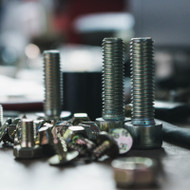The Innovation of Screws: Small Yet Revolutionary
16th Jun 2024
Screws are ubiquitous in modern life, found in everything from furniture to electronics to large-scale industrial machinery. Despite their small size, the innovation behind screws has been revolutionary, shaping how we build, manufacture, and assemble countless items. This blog explores the fascinating history and ongoing innovations in screw technology, highlighting their importance and impact on various industries.
A Brief History: From Simple Fasteners to Precision Tools
The origins of screws can be traced back to ancient Greece, where they were initially used as part of presses for olives and grapes. The true innovation came in the 15th century with the advent of metal screws, thanks to advancements in metalworking. The development of the screw-cutting lathe in the 18th century by Jesse Ramsden marked a significant leap, enabling the mass production of screws with consistent threading.
Thread Design: The Heart of the Screw
The design of the screw thread is critical to its function. Over the years, various thread designs have been developed to suit different applications. The most common types include:
- Unified Thread Standard (UTS): Widely used in the United States, this design is known for its versatility and ease of production.
- ISO Metric Screw Thread: The international standard, ensuring compatibility and uniformity across global markets.
- Acme Threads: Used in applications requiring high strength and durability, such as industrial machinery.
Innovations in thread design have led to improved performance characteristics like increased load-bearing capacity, better resistance to loosening under vibration, and easier installation.
Materials: Enhancing Strength and Durability
The choice of material for screws has a significant impact on their performance. Early screws were made from simple iron or steel, but modern screws come in a variety of materials, each suited to specific environments and applications:
- Stainless Steel: Known for its resistance to corrosion, making it ideal for use in marine and outdoor environments.
- Titanium: Offers an excellent strength-to-weight ratio, used in aerospace and medical applications.
- Brass and Bronze: Preferred in electrical applications due to their conductivity and resistance to sparking.
Recent innovations have introduced composite materials and advanced coatings that enhance the longevity and performance of screws in challenging conditions.
Drive Types: From Slotted to Advanced Security Drives
The head and drive type of a screw determine how it is driven into place. While the simple slotted and Phillips head screws are well-known, innovations have led to more advanced designs:
- Torx and Hex Drives: Provide better torque transfer and reduce the risk of cam-out, making them ideal for precision applications.
- Security Screws: Designed to prevent tampering, these screws are used in public infrastructure and electronics.
These innovations have made screws more user-friendly, efficient, and secure, catering to a wide range of needs from DIY projects to high-security installations.
Applications: Beyond Basic Fastening
Screws are integral to a myriad of applications, often going unnoticed in everyday life:
- Construction and Carpentry: Screws are essential for framing, roofing, and finishing, providing strong and durable connections.
- Automotive Industry: Specialized screws are used in engines, transmissions, and body assemblies, requiring high precision and strength.
- Electronics: Tiny screws hold together delicate components, ensuring stability without damaging sensitive parts.
Innovative screw designs have enabled advancements in these fields, improving product reliability, safety, and performance.
Recent Innovations: Smart Screws and Sustainable Solutions
The latest innovations in screw technology are pushing the boundaries of what these small fasteners can do:
- Smart Screws: Embedded with sensors, these screws can monitor structural integrity and provide real-time data on stress and strain, revolutionizing maintenance and safety in construction and aerospace.
- Self-Tapping and Self-Drilling Screws: These screws save time and effort by eliminating the need for pre-drilling holes, making installation faster and more efficient.
- Eco-Friendly Materials: Research into biodegradable and recyclable materials for screws is paving the way for more sustainable building practices.
These innovations not only enhance the functionality of screws but also contribute to broader technological and environmental goals.
Conclusion: The Unsung Heroes of Innovation
Screws may be small, but their impact on technology and industry is immense. Continuous innovation in screw design, materials, and applications ensures that these humble fasteners remain indispensable in our evolving world. From the simplest household items to the most complex machinery, screws are the unsung heroes that hold everything together, proving that even the smallest components can drive significant advancements.

